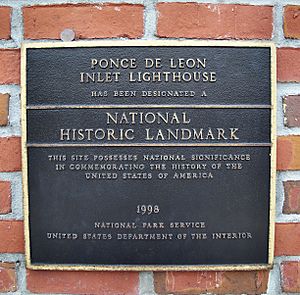Ponce de Leon Inlet Light facts for kids
 |
|
| The Mosquito Inlet Light, later known as the Ponce de Leon Inlet Light | |
| Location | 4931 South Peninsula Dr Ponce de Leon Inlet Ponce Inlet, Florida South of Daytona |
|---|---|
| Coordinates | 29°4′50.22″N 80°55′40.86″W / 29.0806167°N 80.9280167°W |
| Year first lit | 1887 (current structure) |
| Automated | 1953 |
| Deactivated | 1970; reactivated, 1982 |
| Foundation | brick |
| Construction | brick |
| Tower shape | conical tower |
| Height | 175 feet (53 m) |
| Focal height | 159 feet (48 m) |
| Original lens | First order Fresnel lens, 1887-1933, Third order Fresnel lens, 1933-1970 and since 2004 |
| Range | 17 nautical miles; 32 kilometres (20 mi) |
| Characteristic | fixed light (original) Group flashing 6 times every 30 sec (current) |
The Ponce de Leon Inlet Light is a famous lighthouse and museum in Ponce de León Inlet in Central Florida. It stands tall at 175 feet (53 m), making it the tallest lighthouse in Florida. It is also one of the tallest lighthouses in the entire United States. This historic landmark is located between the St. Augustine Light and the Cape Canaveral Light. The Ponce de Leon Inlet Lighthouse Preservation Association helped restore it. In 1998, the lighthouse became a National Historic Landmark.
Contents
History of the Ponce de Leon Inlet Light
The First Lighthouse Attempt
The first lighthouse for this area was built in 1835. It was on the south side of what was then called Mosquito Inlet. Sadly, the oil for the lamp never arrived. Soon after it was finished, a big storm washed away sand from its base. This made the tower weak.
The Second Seminole War began shortly after. In December 1835, Seminole Native Americans attacked the lighthouse. They broke the glass in the lantern room. They also set fire to its wooden stairs. The area was then left empty. The war stopped any repairs from being made. The lighthouse collapsed the very next year.
Building the Current Lighthouse
Many ships crashed along the coast near Mosquito Inlet. But it took until 1883 for a new lighthouse effort to begin. The new lighthouse was finished in 1887. It was built on the north side of the inlet. Its design was based on standard plans. However, some changes were made for this specific location.
Chief Engineer Orville E. Babcock oversaw the building. He sadly drowned in Mosquito Inlet in 1884. The tower was completed, and its lamp was lit in 1887. This powerful light could be seen from 17 nautical miles; 32 kilometres (20 mi) away.
A Famous Shipwreck Story
In 1897, a writer named Stephen Crane was traveling to Cuba. He was going to report on a revolt against Spanish rule. The ship he was on, the SS Commodore, sank off the Florida coast. Crane escaped in a small boat with some crewmen. They eventually saw the Mosquito Inlet Light. They steered their small boat towards it. Crane later wrote about this experience in his famous short story, "The Open Boat".
Changes and Upgrades
The original lamp in the lighthouse burned kerosene. In 1909, it was replaced with a brighter oil vapor lamp. A generator was installed in 1924. This provided electricity for the keepers' homes. It also pumped water, replacing an old windmill. The lighthouse beacon became electric in 1933. A 500-watt lamp was installed. At the same time, the large first-order Fresnel lens was replaced. A smaller, third-order rotating Fresnel lens took its place.
Name Change and New Management
In 1927, the name of Mosquito Inlet was changed. It became Ponce de Leon Inlet. The lighthouse was moved from the Lighthouse Service to the United States Coast Guard in 1939. The Coast Guard managed it for the next 30 years. In 1970, the Coast Guard stopped using the old light station. They set up a new beacon at New Smyrna Beach.
The abandoned lighthouse property was then given to the Town of Ponce Inlet. Local citizens wanted to save the lighthouse. So, the Town of Ponce Inlet accepted the property in 1972. The Lighthouse Preservation Association was formed to run the museum. That same year, the lighthouse was added to the National Register of Historic Places.
The Lighthouse Today: A Museum
In 1982, the lighthouse light was turned back on. This happened because tall buildings were blocking the Coast Guard's new beacon. On August 5, 1998, the Ponce De Leon Inlet Light Station was named a National Historic Landmark. It is one of only eleven lighthouses to receive this special honor.
The lighthouse and three keepers' homes have been restored. They are now open to the public every day. Visitors can climb the lighthouse tower. The museum displays the original 1867 Barbier et Fenestre first-order lens. This lens was installed in 1887. Also on display is an 1860 "Henry Lepaute" rotating first-order Fresnel lens. This lens was once used at the Cape Canaveral Light Station.
The 1904 Barbier, Benard, et Turenne rotating third-order Fresnel lens is back in service in the tower. It works today as a private aid to navigation. Museum staff maintain it. The lighthouse is just south of Daytona Beach.
See also
 In Spanish: Faro Ponce de León para niños
In Spanish: Faro Ponce de León para niños




